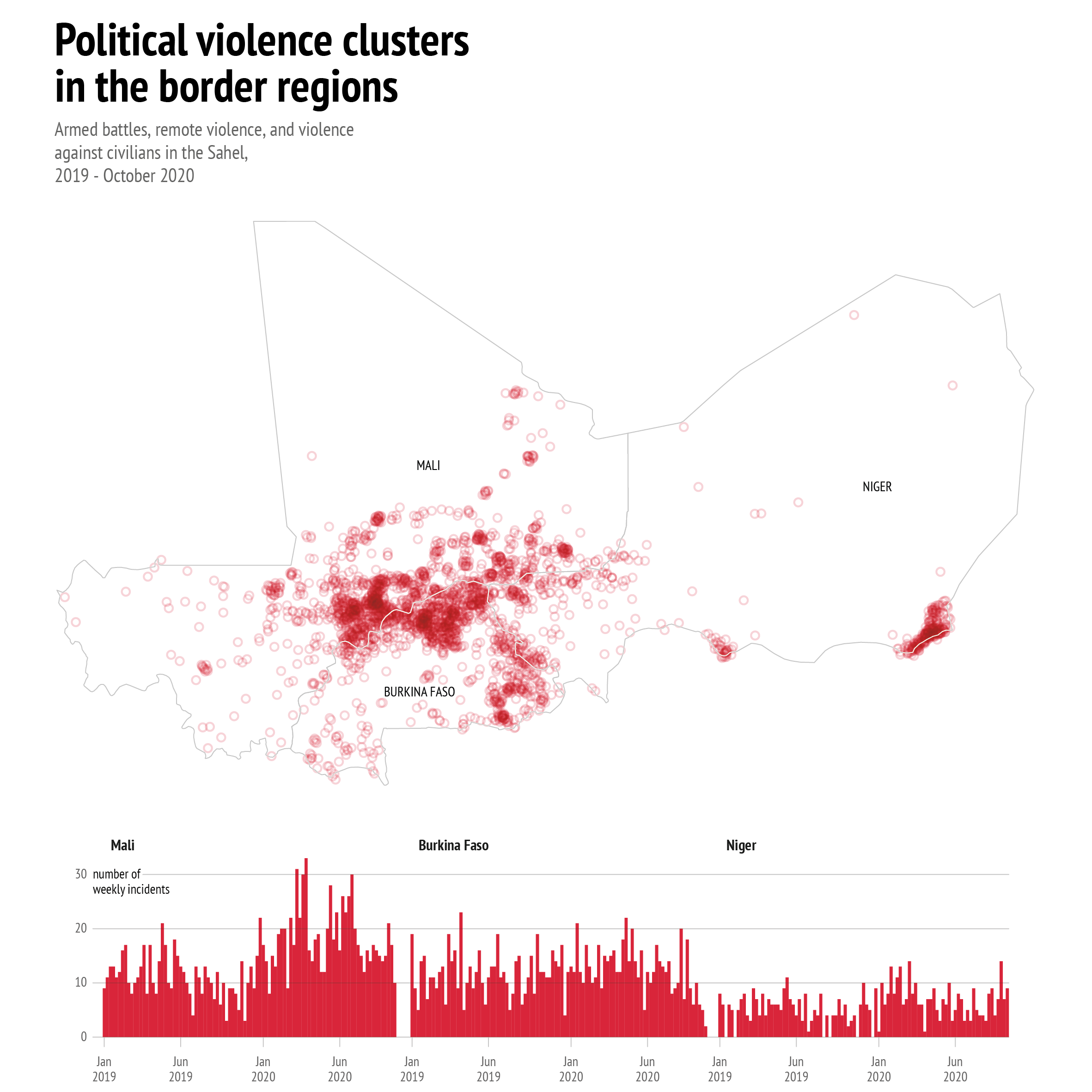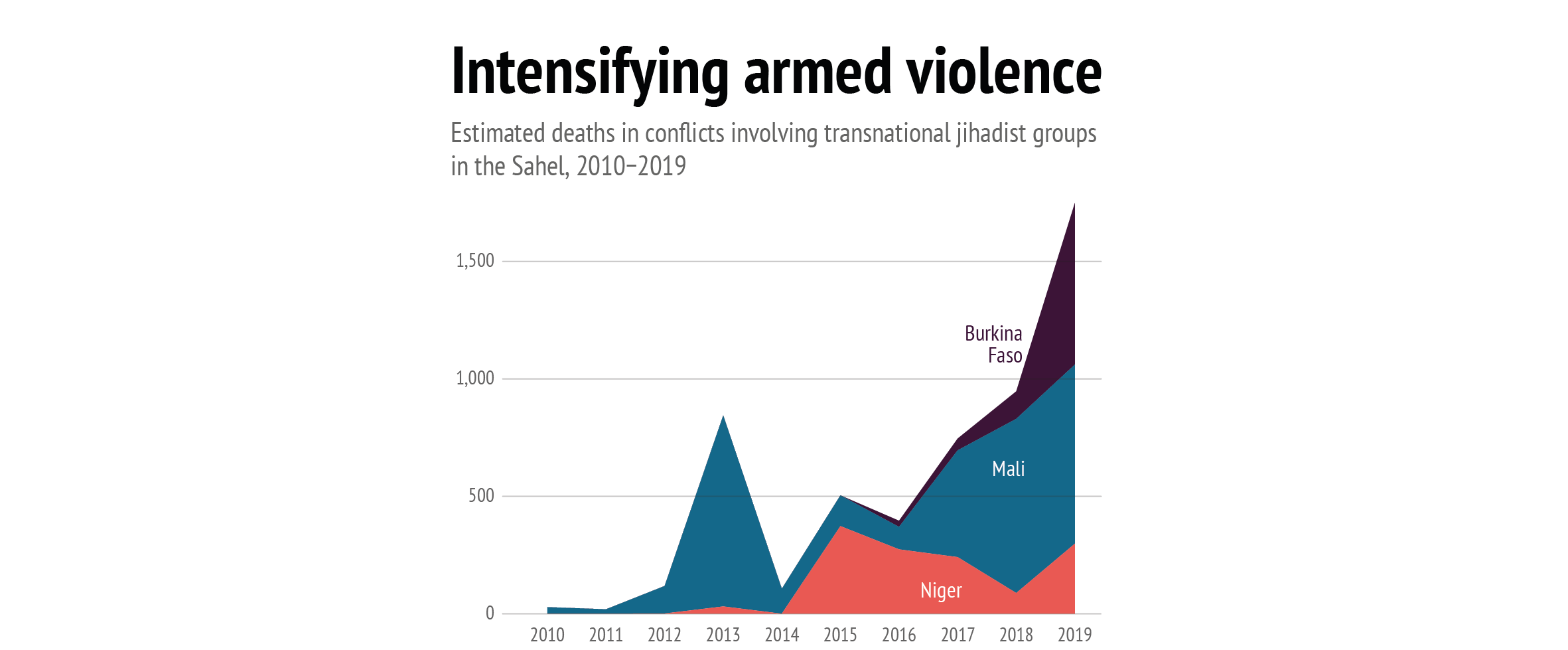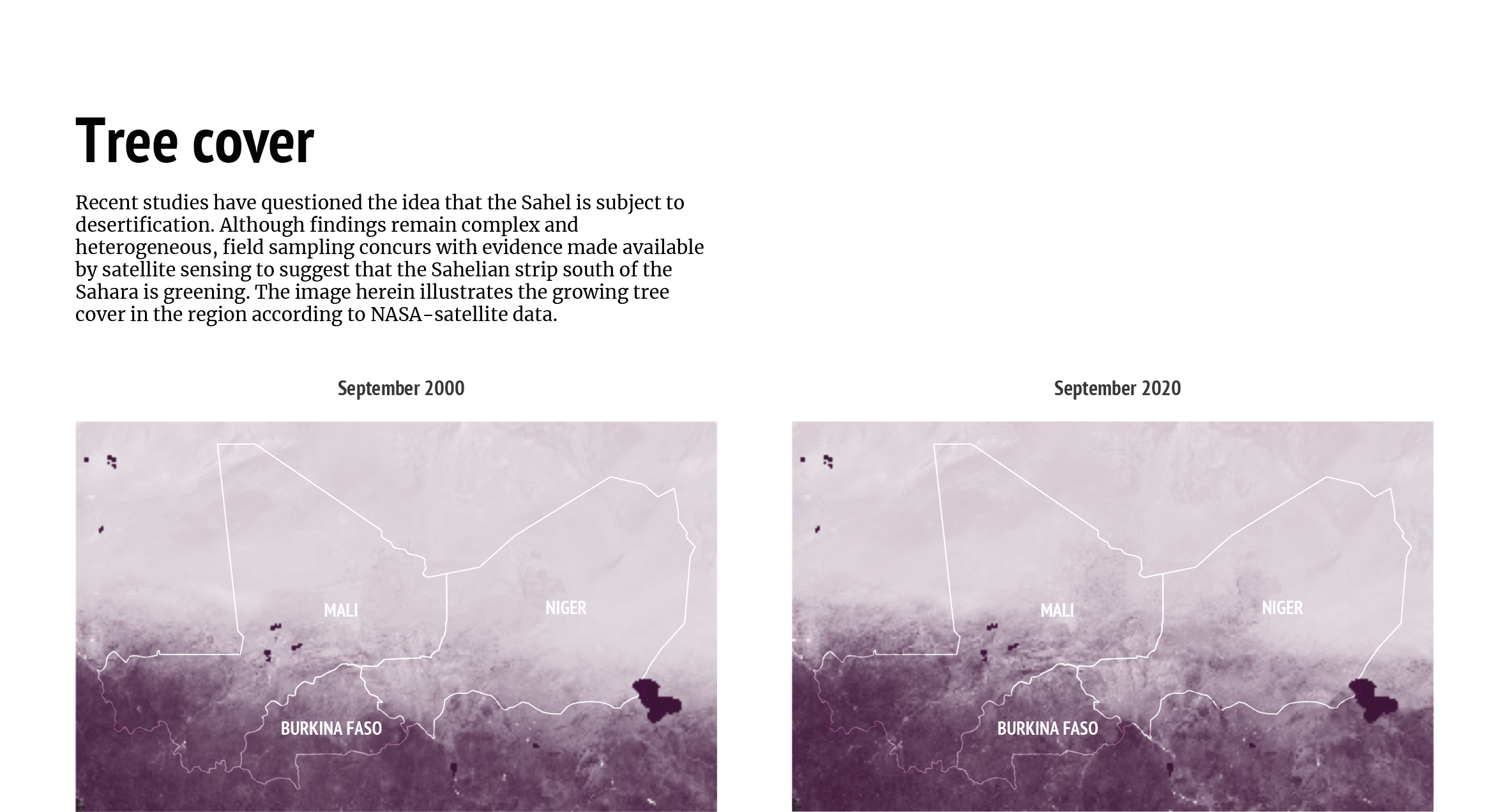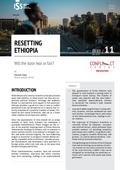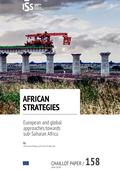You are here

Sahel Climate Conflicts? When (Fighting) Climate Change Fuels Terrorism
Introduction
Levels of armed violence in the Sahel are skyrocketing. Conflict metrics show that the region is caught in a spiral of insecurity.1 Communal violence and jihadist insurgencies have significantly undermined local states’ grip over large parts of their territories, particularly in the three-border area straddling Mali, Burkina Faso and Niger. Amidst the proliferation of non-state armed groups, attacks by terrorist groups linked to al-Qaeda or the Islamic State networks have risen sharply since 2015.
Policy and media discourses suggest that soaring terrorist violence is linked to, if not driven by, climatic and environmental factors. In the Sahelian context – the argument goes – in a region characterised by environmental degradation and sustained population growth, climate change has the potential to exacerbate competition over dwindling resources, fuelling conflict escalation and radicalisation. This narrative draws on global discourses about resource conflicts and climate wars, and contributes to shaping security and development policies targeting the Sahel. Climate change mitigation and environmental protection measures are thus seen as structural preconditions to tackle the root causes of the Sahel’s insecurity and rising (jihadist) violence.
The idea that terrorism and climate change are somehow connected is a seductive one. It offers international donors the opportunity to kill two birds with one stone by addressing jointly what are arguably the most pressing issues facing the international community, thereby overcoming political divides. And it provides local governments with a narrative that depoliticises conflicts and downplays their own responsibilities. However, such simplistic Malthusian arguments that connect terrorism in the Sahel to climatic and environmental factors do not stand up to empirical scrutiny. Whether and how natural resources are associated with conflicts’ onsets and dynamics, and to what extent climate change has the potential to exacerbate these trends, are questions that remain highly contested. Just as much as with other issue-areas of climate change, there is no shortage of unsubstantiated misconceptions about climate and conflict, and environment and security more broadly.
This Conflict Series Brief sets out to illustrate that misconceived environmental security policymaking, especially when based on rhetorical shortcuts that overlook and contradict the most recent evidence, is not only ineffective, but can have radically adverse impacts. Even if well-intentioned, climate change mitigation and environmental protection measures based on false premises may result in conflict exacerbation, rather than resolution: a situation that violent jihadist entrepreneurs exploit. To this end, the Brief scrutinises three programmes rolled out in the Sahel to fight desertification, prevent food crises, and preserve wildlife which have ended up contributing to the encroachment of terrorist groups in the region. The lessons learnt from these cases helps highlight the policy implications for existing and future efforts to fight violent extremism and promote sustainable development sponsored by the Sahel’s international partners, including the EU.
Climate conflicts: evidence- or myth-based?
Security strategies targeting the Sahel have eagerly embraced a narrative that explains soaring conflict and terrorism as a result of intensified competition for dwindling resources, exacerbated by climate change. Speaking in 2012 before the Security Council, today’s UN Secretary-General Antonio Guterres claimed that “The countries of the Sahel are among the main victims of the accelerating effects of climate change. [...] Poverty and underdevelopment, exacerbated by desertification and the effects of climate change, are being exploited by ideologies that are either based on ethnicity or religious extremism”.2 Similarly, a 2014 report by the UN Convention to Combat Desertification Secretariat argued that terrorist attacks were more frequent in countries experiencing desertification, including in the Sahel.3 Such framing has subsequently inspired UN strategies and support plans for the Sahel. Regional organisations, too, have embraced the idea that the fight against environmental degradation can contribute to tackling the drivers of violence and terrorism in the Sahel. This view permeates the 2011 EU Sahel Strategy and the 2015 Regional Action Plan, the 2018 Alliance for the Sahel Development Programme, the 2019 G7 Sahel Partnership Action Plan, as well as the African Union’s (AU) Declarations and institutional setup.4
Despite such a proliferation in policy discourses, the evidence made available by natural and social science puts the alleged links between climate variability, environmental degradation and conflict in the Sahel into question. This is not to deny the existence of climate variability and conflict escalation in the region: but the connection between the two is less straightforward than often claimed. Scholarly attempts to draw automatic correlations between environmental variables and conflicts, let alone terrorism, have so far yielded inconclusive results.5 Profound methodological disagreements persist, and the lack of contextualisation and socio-political analysis make large-scale empirical studies and big data highly unlikely to generate consensus.6 Overall, however, the hypothesis that a causal link, or nexus, does indeed exist between climate events, dwindling resources and violent conflicts, let alone terrorism, is not adequately supported by conclusive scientific evidence.
Disagreements persist not only about the possible correlations between climatic factors and conflict outputs, but also, at an even more basic level, about whether, and what, climate variability and change is being experienced in the Sahel. The rising temperatures recorded in the region arguably drive the widespread impression that the Sahel is suffering from severe climatic deterioration.7 Yet a fine-grained analysis suggests a more cautious interpretation is required. Rising temperatures across the region are widely acknowledged, but unevenly recorded. Marked temperature increases in Mali,8 for instance, contrast with Niger’s temperatures, which are also rising, but below the mean global warming level.9 Overall, climatologists tend to agree that the Sahel’s climate is one of extremes: this implies that exceptional weather and climatic events are paradoxically the norm, especially if longer time-spans are examined. Historical records and geological data both confirm that multi-decadal droughts have occurred quite regularly throughout the Sahel’s history, leading climatologists to conclude that “there is no such thing as ‘normal’ rainfall in the Sahel”.10 The lack of a baseline undermines comparisons, making the detection of variations highly dependent on the arbitrary choice of the time period selected. Compared to the past decade, for instance, rainfall has significantly increased in some parts of the Sahel, including in the region of Agadez.11 Researchers have also disputed that the Sahel is undergoing a process of desertification. While desertification was noticeable in the 1970s, more accurate evidence made available by satellite sensing has suggested that the process is reverting. The Sahelian strip south of the Sahara is reportedly much greener than it used to be 30-40 years ago, and possibly than at any point in history for which data is available, with denser tree cover and an increase in water bodies.12 Furthermore, the overall agricultural output of Sahelian countries has significantly increased in recent years, keeping pace with (and often exceeding) the sustained population growth of the region.13 This observation undermines the idea that environmental degradation has exacerbated conflict over the access to scarce resources, and aligns with existing evidence that food availability, both globally and locally, is theoretically enough to meet existing demands.
A more complex (and political) story
Even if one assumes that the Sahel is experiencing some sort of climatic “crisis”, available environmental security studies focusing on the Sahel have so far failed to produce strong evidence and generate consensus on whether (and what) climatic factors impact conflict variability (and how), let alone on terrorism and violent extremism. For instance, Benjaminsen et al.14 dispute that any meaningful correlation exists between droughts and conflicts over access to resources in the Sahel. A World Bank report found instead a tenuous link between droughts and conflict onset in the region,15 but its results are not robust to replication.16 Even when rainfall variability (both lack and excess) is taken as a proxy of climate change, the impact on conflict remains unclear, with an Organisation for Economic Co-operation and Development (OECD) study17 finding only a weak correlation, which incidentally relies on a very broad definition of what counts as conflict. Similarly, scholars disagree as to whether the decreasing water level of Lake Chad has led to conflict escalation – because of greater competition for resources18 – or appeasement – because of the greater accessibility of fertile lands made available by the shrinking of the lake.19
The climate-conflict literature on the Sahel shows that a narrow focus on mechanical connections deducted from abstract variables is insufficient. Departing from the Malthusian assumptions of early studies, then, recent research approaches conceptualise climate variability and change less as direct drivers of conflict than as threat multipliers, interacting in complex ways with pre-existing vulnerabilities such as livelihood insecurity and governance issues that mediate between environmental stressors and societal outcomes. Ethnographic studies have already begun to unearth the complex relationship between formal and informal institutions regulating access to natural resources, conflict escalation and terrorist mobilisation in the Sahel.20 A qualitative analysis helps comprehend social phenomena in a more holistic and nuanced manner, and therefore enhance context- and conflict-sensitivity in order to avoid counterproductive policy outcomes.
The climate-conflict nexus reversed: environmental protection failures
Environmental security policies in the Sahel are, by and large, shaped by policy, military and non-governmental organisation (NGO) actors who appear to see limited added value in the inputs of social science. As a result, climate change mitigation and environmental protection measures in the region have mostly failed to keep up with the standards of evidence-based policymaking. This neglect has paved the way to spectacular failures, as demonstrated by the following three case studies.
Failure 1: rise and fall of the Forest Service
Rising temperatures and desertification in the Sahel have often been considered closely linked to unsustainable patterns of deforestation and logging. These, in turn, are typically viewed as a function of the Sahel’s population growth, and the related demand for wood to meet rising cooking, housing and farming needs. As woods are traditionally treated as commons freely accessible to all, is claimed that the “tragedy of the commons” has made logging spiral out of control, with desertification resulting from aggregate self-regarding (mis)conducts.21
The argument is rather simplistic, in as much as its strong rational-choice assumptions may lead to the overlooking of the mitigating effect of existing informal regulatory schemes to balance individual and collective interests. Be that as it may, the argument has proved highly consequential in shaping policy responses. On the one hand, it has reactivated among international donors the appeal of late-colonial projects to stop the southward advance of the Sahara through intensive reforestation programmes at the edge of the desert. Dubbed the “great green wall”, the idea (re-)gained momentum in the 2010s, with the endorsement of the UN Conference on Sustainable Development in 2012, of the UN Food and Agriculture Organisation (FAO) in 2014, and eventually of the Paris Summit on Climate Change in 2015, which raised $4 billion in donors’ pledges for this gigantic project.22
On the other hand, Sahelian governments, while welcoming international aid for reforestation, have often moulded the normative push to protect a fragile environment and its natural resources by privileging expeditious law enforcement measures rather than long-term sustainability. To this end, over the last few decades Sahelian countries have considerably empowered their respective Forest Services (Eaux et Forêts) and ranger corps.23 These are paramilitary agencies inherited from colonial rule and tasked with enforcing the conservation of natural resources. The transition from colonial domination to post-colonial authoritarian regimes has smoothed the continuity of coercive practices mandated by political elites against “unruly” rural subjects. In 1986, for instance, Mali’s military leadership amended the colonial law establishing the Forest Service by increasing the severity of penalties, inflating the fines and authorising heavy-handed approaches to inhibit informal logging: all this was with the financial and political support of international donors seeking to avert further environmental crises and uphold a sustainable development agenda.24 Living on the frontier between the savannah and the desert, where anti-desertification efforts are concentrated, some Fulani communities, and especially the landless semi-nomadic shepherds, have felt particularly burdened by these policies. They lament excessive fines for firewood collection, informal taxation akin to extortionary practices, and deliberate acts of humiliation which show contempt for local values and social norms. Mali is not an isolated case. Today, Forest Service officers across the entire Sahel are frequently accused of engaging in rent-seeking and extortion, preying on marginalised rural communities through embezzlement, harassment, plunder and abuses.25 The consolidation of patronage networks has fuelled widespread perceptions of an almost complete impunity for the Forest Services of Sahelian countries, who are seen to be operating in tacit partnership with national political elites and local customary leaders.
Violent entrepreneurs have proved skilled at tapping into this deep-seated sense of frustration and powerlessness. Jihadist leaders such as Katiba Macina’s Amadou Koufa and Ansaroul Islam’s Ibrahim and Jafar Dicko have built their reputation and gained some degree of local acceptance by engaging in rhetoric that leverages Sahelian countries’ bad governance and corrupt practices with respect to the management of natural resources.26 In their narrative, the everyday experience of the abuses allegedly suffered by marginalised communities is presented as evidence of a transnational conspiracy that blends together Sahelian governments, corrupt customary leaders acting as their informal puppets, their international backers (and masterminds) in the West, as well as the abusive state security apparatuses, of which the Forest Service is one of the first in line. It is therefore hardly surprising that Forest Service officers have often been the primary targets of terrorist attacks in both central Mali and northern Burkina Faso.27 The harsh, unchecked implementation of measures originally intended to fight deforestation and desertification may therefore have contributed to fuelling terrorist violence in the Sahel, rather than averting it.
Failure 2: from food shortage to land shortage
Another policy area which exhibits misguided assumptions about the links between environment and security is that of food policies. Sahelian countries’ environmental fragility makes them prone to food crises. Since colonial times (and possibly before), policymakers have thus repeatedly attempted to strengthen food security by enhancing domestic production. At the same time, international donors have sponsored the adjustment of Sahelian agriculture in order to prevent further food crises, with generous programmes presented using the language of modernisation and efficiency.
Overall, these policies have been successful vis-à-vis their stated objectives. FAO statistics28 show that the prevalence rates of malnutrition and undernourishment have declined (albeit unevenly) across the Sahel, while overall food security has increased. At the same time, the production of cereals and staples in the Sahel has boomed from independence to now: six-fold in Niger, seven-fold in Burkina Faso, and almost ten-fold in Mali.29 In all these countries, the most significant improvement has been observed in the last 30 years, i.e. after the environmental and food crises of the 1980s. The surface of arable land available to crop farming has also drastically expanded in Sahelian countries, especially in the last few decades.
These observations contribute to questioning the idea that environmental degradation interacts with population growth to fuel conflicts over access to dwindling resources. The Mopti region, in central Mali, could theoretically provide a most likely case for this theory to hold: here, fragile agro-pastoral food production systems coexist, and the region has indeed become the hotspot of communal clashes and terrorist attacks in the last few years. Yet disaggregating data at sub-national level corroborates the same conclusion: in the Mopti region, cereal production has tripled while the area under cultivation has also grown by 26% as compared to 15 years ago.30
Available data, then, does not support the Malthusian clear-cut correlation that underpins the climate-conflict argument. The problem, in fact, does not appear to lie in the scarcity of food (which has markedly declined), but in the production thereof. Understanding this requires a more nuanced interpretation, combining econometric statistics with a political economy analysis. After all, enhancing food production intersects with powerful vested interests of local stakeholders, and can hardly be seen as a mere technocratic endeavour.
Throughout the years, Sahelian food policies have devoted a much greater share of attention – and resources – to agriculture rather than to animal farming, not only for the perceived greater food output of the former, but also, and importantly, because of its alignment with the ideological and economic interests of ruling elites in Sahelian capitals. The cultivation of land previously allocated to grazing, including marginal lands and transhumance routes, is therefore the result of deliberate policy choices, and not of mere adjustments to demographic pressure. As the expansion of arable land and cereal production across the region has largely been achieved to the detriment of pastoralism, those relying on this activity have grown increasingly frustrated. The rise in conflicts related to land allocation and use, combined with the decreasing confidence in judicial and traditional dispute settlement mechanisms, has fuelled a strong demand for protection by animal farmers.31 Jihadist groups have been particularly skilled at exploiting the inter- and intra-communal clashes that ensued, by articulating a narrative of a struggle between the marginalised and disenfranchised against greedy imperialists and their local puppets for the reinstatement of traditional grazing rights.
The argument connecting conflict and terrorism to resource competition, then, can retain some value only if it is referred not so much to food availability per se, but to the factors of food production and their governance, first and foremost the land. Sahelian governments can find it convenient to link terrorism and climate change: it helps attract financial assistance by connecting two issues that mobilise international donors. One should keep in mind, however, that “development projects do not merely generate wealth; they also contribute to a profound modification of local conditions of access to resources in an already highly competitive environment”.32 Premised on the assumption of resource scarcity, development (or security-development) policies that overlook this aspect and only aim to increase agricultural output run the risk of aggravating the problem they are meant to address. Overly ambitious investment plans to tackle climate change and enhance food production (such as the one launched in Niamey in early 2019, worth over $400 billion)33 should be looked at with circumspection, and always include scrupulous conflict-sensitivity analyses.
Failure 3: protecting wildlife, sacrificing citizens
Poorly regulated land transformation and indiscriminate hunting, often driven by demographic pressure, have prompted a drastic decline of biodiversity in the Sahel. Wildlife is particularly at risk: several species, including endemic antelopes, giraffes, gazelles and elephants are endangered or perilously close to extinction. Statistical inferences suggest that biodiversity loss in Africa is closely associated with armed violence escalation,33 prompting the recommendation to hinder both phenomena by enhancing conservation measures and wildlife protection through natural sanctuaries. While this is a commendable objective per se, an in-depth analysis suggests that, in the absence of appropriate governance schemes, the establishment of natural parks and reserves can also lead to conflict escalation, rather than appeasement, and contribute to creating a fertile ground for terrorist groups.
Burkina Faso provides a good illustration of this. Sensitised by transnational environmentalist networks and hoping to attract international ecotourism, Burkinabé authorities have demonstrated a growing resolve to establish protected areas and natural sanctuaries. Eastern regions have been especially targeted, owing to their lower population density and higher wildlife concentration. Yet the sanctuarisation of large swathes of eastern Burkina Faso for recreational purposes has been achieved without due regard for local dwellers’ livelihoods. The Forest Service was tasked with enforcing restrictive measures impeding access to natural resources, with the country's authoritarian rulers reportedly condoning brutal and abusive behaviour when implementing forcible expulsions without compensation.35 This nurtured an increasing sense of frustration among some rural communities, who felt they were being dispossessed and discriminated against in order to facilitate the leisure activities of urban elites and international tourists. In the early 2000s, international donors encouraged the adoption of mitigating measures to better share the profits of wildlife tourism with local communities, and provide adequate recognition to traditional social practices such as seasonal bush fires and transhumance.36 Yet from the mid-2010s, international donors’ changing priorities reversed this approach, with a renewed emphasis on preventing cross-border movements and strengthening security. The crackdown on informal practices that ensued further contributed to deepening the gulf between central state rulers and the marginalised ruled. In 2016, for instance, violent riots erupted near the Pama natural reserve in the aftermath of the killing of two alleged poachers by the Forest Service.37
These tensions have contributed to creating a fertile ground for terrorist groups in the east of Burkina Faso. Jihadist organisations proliferating in the region have skillfully deployed a narrative combining social and religious discourses to present themselves as providers of protection and justice against the perceived abuses of state authorities. By targeting security forces, and Forest Services first and foremost, they have ensured that local dispossessed communities have unconstrained access to natural resources. According to local observers: “today, when a powerful [non-state armed] actor arrives in the area, the promotion of a more efficient access and management of natural resources facilitates greater acceptance by local populations”. As a result, armed groups, including terrorist ones “are seen as an opportunity to improve the situation of pastoralists and especially access to environmental resources”.38 Local acceptance of jihadists groups has reportedly increased, alongside poaching and wildlife smuggling.39 These dynamics prompt the observation that the authoritarian, non-inclusive implementation of ill-thought-out wildlife conservation measures in Burkina Faso has provided a golden opportunity for violent entrepreneurs-turned-violent extremists to mobilise.
The way forward
The Sahel is facing a prolonged, multifaceted crisis, with violent conflicts and rampant jihadism taking place amidst environmental degradation and disruptive climatic events. In this framework, the idea that climate change drives conflict escalation by exacerbating competition over dwindling resources is widespread. This claim does not stand up to empirical scrutiny. Environmental factors, climatic variables and conflict dynamics interact in complex ways that fail to exhibit demonstrable causal links. Available scientific evidence then forbids to conclude whether, how and what climatic factors impact on conflict variability, let alone on terrorism and violent extremism, be it in general or in the Sahel specifically. Nevertheless, the climate-conflict narrative has proved remarkably resilient. Wrong assumptions and unsubstantiated misconceptions about environmental factors and conflict outcomes have continued to shape security and development policies targeting the Sahel. This Brief has examined three cases of programmes rolled out in the Sahel to fight desertification, prevent food crises, and preserve wildlife that have ended up contributing to the emergence of terrorist groups in the region. While the factors driving the rise of terrorism in the Sahel remain complex and multi-faceted, these cases indicate that the governance frameworks regulating access to natural resources are key to processing environmental and societal stressors, making them veer towards either conflict escalation or mitigation. The narrow focus on abstract variables privileged by large-scale big data studies may then be inappropriate.
A more qualitative, fine-grained account allowing for contextualisation and socio-political nuance may be better suited to grasping the complex interactions between climate variability and conflict escalation. That such an approach inhibits generalisations may be after all good news for policymaking: lacking context-sensitivity, one-size-fits-all responses to security challenges are recipes for failure. The problematic cases analysed in this Brief provide valuable lessons to be learnt and incorporated in future programmes of environmental protection and sustainable development sponsored by the Sahel’s international partners, including the EU. Violent (extremist) entrepreneurs leverage the grievances of rural people who feel marginalised, dispossessed, and deprived of decision-making about the allocation and use of natural resources. Vulnerability increases when environmental protection is administered top-down, whether by technocratic elites or authoritarian regimes, without adequate participation and inclusion of local communities. The counter-factual argument is also true. There is no shortage of examples of positive interactions between Sahelian administrations, international donors and rural communities, whose buy-in in environmental protection projects has ensured sustainability and resilience to violent extremism. This is, for instance, the case of the design and implementation of the Integrated and Sustainable Development Programme in the Sourou river plain in Mali: in an area characterised by acute ethnic tensions and frequent terrorist attacks, the community feels that the participative management of natural resources has ‘laid a foundation for preventing the further escalation of conflict by improving natural resource governance in the region’.40
Similarly, the management of the Gourma Elephant Reserve in Mali contrasts sharply with that of the Pama National Park in Burkina Faso. The Gourma area hosts the northernmost community of elephants in Africa. International NGOs and the UN have sponsored inter-communal dialogues to raise the awareness and build the resilience of the community against elephant poaching. The conservation project reportedly enjoys a considerable degree of support from local people, despite the constant threat of smugglers and terrorist groups proliferating in the area.41
It would be wrong, as well as clearly paternalistic, to assume that Sahel rural communities are stubbornly and inherently uninterested in – if not overtly opposed to – environmental protection and climate change mitigation. Throughout the centuries, traditional African practices have devised ingenious and sophisticated techniques to ensure the production and reproduction of natural resources, achieving a careful environmental balance between natural and anthropogenic systems. Jihadist leaders have proved particularly skilled at monopolising the revival of traditional Sahelian modes of natural resource governance, with their message favourably received by rural communities disillusioned by the mirage of modernity. Aligning this revival with the international concern for environmental protection could contribute to undermining jihadist propaganda. For though bad climate change mitigation policies can aggravate the terrorist threat, as this Brief has argued, good ones can help prevent terrorism.
References
[1] See, for instance, ACLED: (https://acleddata.com/#/dashboard), and MENAstream: (https://menastream.com/blog/).
[2] Statement by the UN High Commissioner for Refugees to the UN Security Council, December 10, 2012, http://www.unhcr.org/50c7346e9.html.
[3] UNCCD, Desertification: the invisible frontline (Bonn: UNCCD, November, 2014).
[4] Bernardo Venturi, “An EU Integrated Approach in the Sahel: The Role for Governance”. IAI Papers 19/03, February, 2019; Vane Aminga and Florian Krampe, “Climate-related security risks and the African Union”, SIPRI Policy Brief, May, 2020.
[5] Thomas Homer-Dixon, “Environmental scarcities and violent conflict: evidence from cases”, International Security 19, no. 1, 1994.
[6] Jan Selby, “Positivist Climate Conflict Research: A Critique”, Geopolitics 19, no. 4, 2014.
[7] IPCC, Special Report: Global Warming of 1.5° C, 2018.
[8] Chitra Nagarajan, Mali: Climate-Fragility Risk Brief, May, 2020.
[9] Aoife McCullough, Leigh Mayhew, Sarah Opitz-Stapleton, When rising temperatures don’t lead to rising tempers. Climate insecurity in Niger, BRACED Knowledge Manager Report, October, 2019.
[10] Mike Hulme, “Climate perspectives on Sahelian desiccation: 1973-1998”, Global Environmental Change 11, no. 1, 2001, p.19.
[11] ICG, “The Central Sahel: Scene of New Climate Wars?”, Crisis Group Africa Briefing 154, April, 2020.
[12] Tor Benjaminsen, “Let the Desertification Zombie Rest in Peace”. PRIO Blog Climate and Conflict, December 4, 2017. https://blogs.prio.org/ClimateAndConflict/2017/12/let-the-desertification-zombie-rest-in-peace/.
[13] ICG, “The Central Sahel”.
[14] Tor Benjaminsen, Koffi Alinon, Halvard Buhaug, Jill Tove Buseth. “Does climate change drive land-use conflicts in the Sahel?”, Journal of Peace Research 49, no. 1, 2012.
[15] Erik Alda, “Rising tempers, rising temperatures: a look at climate change, migration and conflict and the implications for youth in the Sahel,” World Bank, March, 2014.
[16] McCullough et al., When rising temperatures.
[17] Sebastien Hissler, “Econometric study on the impact of rainfall variability on security in the Sahel region,” OECD, January, 2010.
[18] Katharina Nett, Lukas Rüttinger. “Insurgency, Terrorism and Organised Crime in a Warming Climate. Analysing the Links Between Climate Change and Non-State Armed Groups”, Adelphi, October, 2016.
[19] Géraud Margin, Marc-Antoine Pérouse de Montclos, “Crisis and Development. The Lake Chad region and Boko Haram,” AFD, 2018.
[20] Mirjam de Bruijn, Hans van Dijk, “Drought and Coping Strategies in Fulbe Society in the Haayre (Central Mali): A Historical Perspective”, Cahiers d'études africaines 34, no. 3, 1994; Tor Benjaminsen, Boubacar Ba, “Why do pastoralists in Mali join jihadist groups? A political ecological explanation”, The Journal of Peasant Studies 46, no. 1, 2018.
[21] UNESCO, 2003. Education Kit on Combating Desertification, UNESCO, 2003.
[22] Benjaminsen, “Let the Desertification”.
[23] Benjaminsen and Ba, ”Why do pastoralists”.
[24] Nagarajan, Mali.
[25] Luca Raineri, “If Victims Become Perpetrators: Factors Contributing to Vulnerability and Resilience to Violent Extremism in the Central Sahel”, International Alert, June, 2018.
[26] Niagalé Bagayoko, Boubacar Ba, Boukary Sangaré, Kalilou Sidibé, “Gestion des ressources naturelles et configuration des relations de pouvoir dans le centre du Mali : entre ruptures et continuité”, ASSN, June, 2017.
[27] Raineri, “If Victims”; Nicolas Hubert, “Burkina Faso : un terreau pour la propagation du conflit malien ?”, Centre Franco-Paix en Resolution de Conflits Report, UQAM, July, 2019.
[28] Data extrapolated from: http://www.fao.org/faostat/en/#home.
[29] As a matter of comparison, throughout the same timespan food production in the US has ‘only’ tripled, while in neighbouring Nigeria and Algeria – the regional leaders – it has increased by a factor of four and five, respectively.
[30] ICG, “The Central Sahel”.
[31] Bagayoko et al., “Gestion des ressources”.
[32] ICG, “The Central Sahel”, 7.
[33] “Changement climatique: un plan de 400 milliards de dollars pour le Sahel”, RFI, February 26, 2019, https://www.rfi.fr/fr/afrique/20190226-niger-plan-changement-climatique-sahel-milliards.
[34] Joshua Daskin, Robert Pringle, “Warfare and wildlife declines in Africa’s protected areas”, Nature 553, 2018.
[35] Hubert, “Burkina Faso”.
[36] Maano Ramutsindela, Sylvain Guyot, Sébastien Boillat, Frédéric Giraut, Patrick Bottazzi, “Geopolitics of Protected Areas”, Geopolitics 25, no. 1, 2020.
[37] Hubert, “Burkina Faso”.
[38] Quotes from interviews with local NGO. In: Hubert, “Burkina Faso”.
[39] William Assanvo, Baba Dakono, Lori-Anne Théroux-Bénoni, Ibrahim Maïga, “Extrémisme violent, criminalité organisée et conflits locaux dans le Liptako-Gourma”, ISS West Africa Report 26, December, 2019.
[40] Fransje Molenaar, Sibout Nooteboom, “Improving decentralised natural resource management in the Sahel. The case of the Sourou river plain in Mali”, CRU Policy Brief, Clingendael, June, 2020.
[41] Phone interview with NGO worker, SOS Elephants Gourma.
